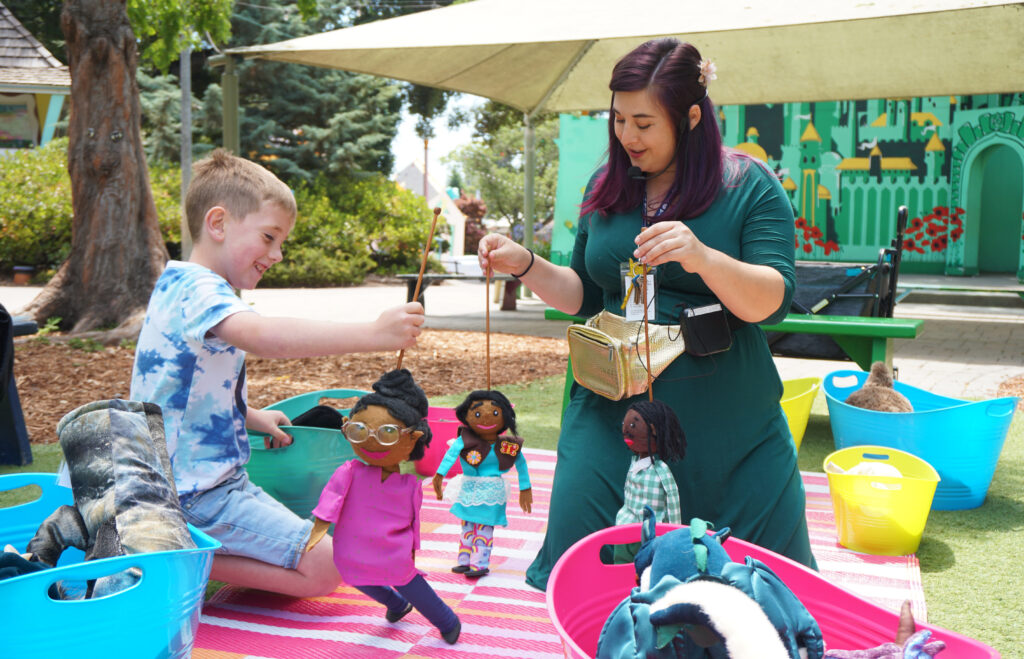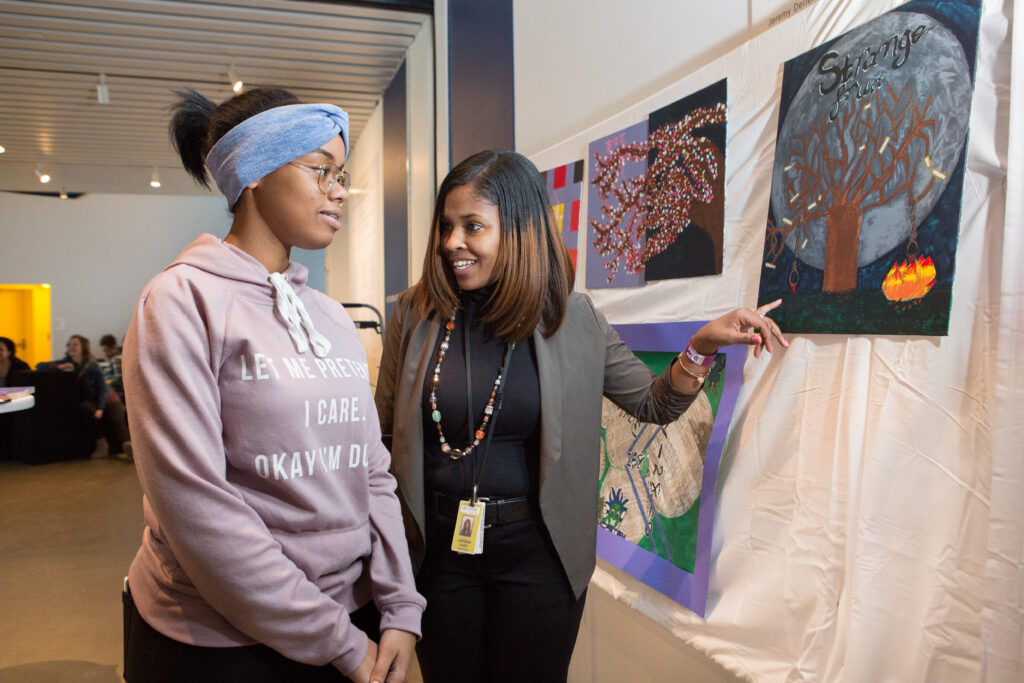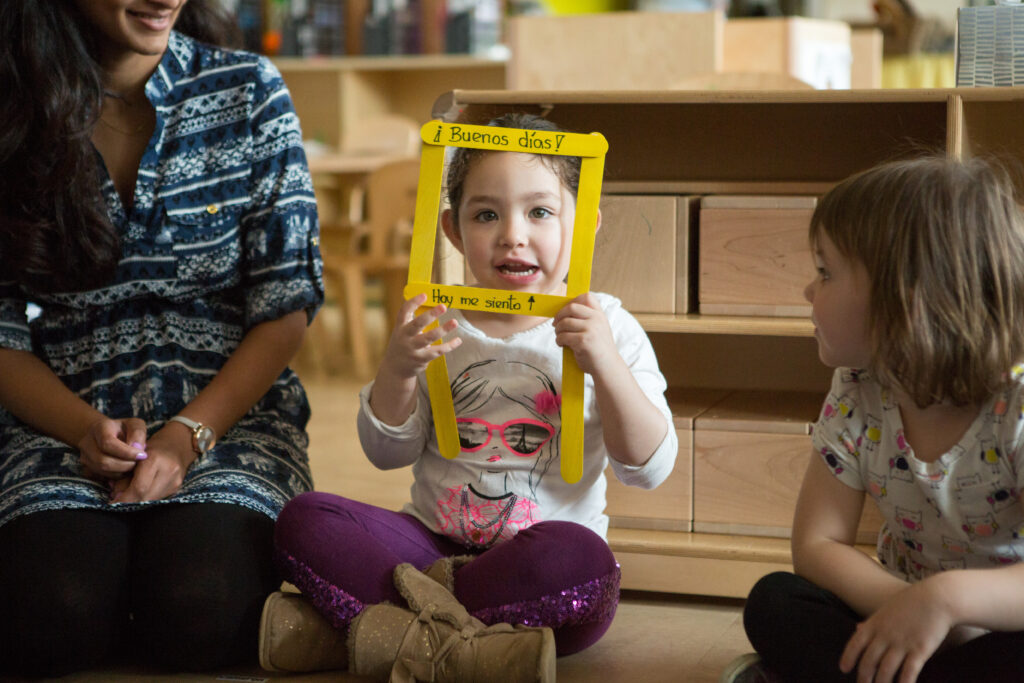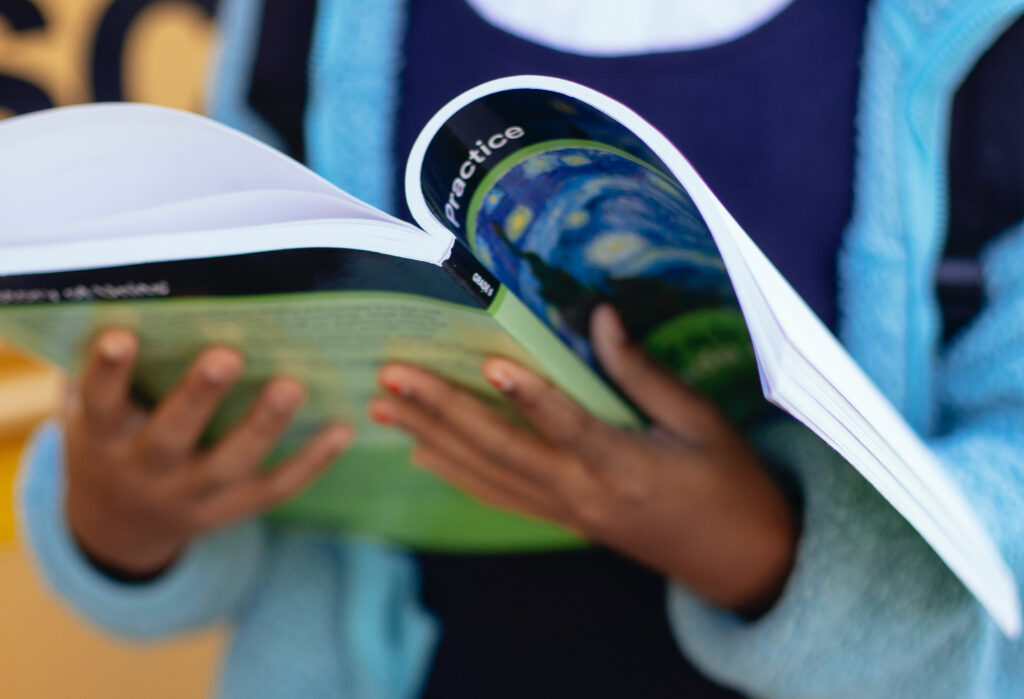
The Dunamis House in Boyle Heights is owned and operated by Los Angeles Room & Board.
Credit: Los Angeles County Homeless Initiative
A home in the middle of Los Angeles has become an oasis for young adults brought together by one particular experience: homelessness.
The Dunamis House, located on Evergreen Avenue and two blocks away from Cesar Chavez Boulevard, offers a multitude of free services: a furnished room, freshly prepared meals, haircuts, workshops on topics like financial literacy, workout classes and more. Residents can also earn an income by working at the on-site café.
“There is no place like this. This is one of one,” said Sherbert Diaz, a Dunamis resident who moved into the home in December. “It gave me the opportunity to understand who I am and to leave the survival mode.”
Providing young adults with respite from the instability of homelessness is central to the mission of Los Angeles Room & Board, known as LAR&B, the nonprofit that owns and operates Dunamis House and three other homes in East Hollywood, West Adams and Westwood that serve the same purpose.
The organization was founded in 2020 by Sam Prater, who credits his 14 years of working in university student housing, plus his own experience of homelessness as a young adult, as the inspiration behind LAR&B.
“Offering someone a safe place to sleep is only one part of our mission,” Prater said. “The real work is trying to transform lives, and through the services that we provide and our incredible team, that’s where the real work happens.”
Homelessness has skyrocketed in Los Angeles in recent years. More than 6,000 children ages 0 to 17 and almost 4,000 young adults ages 18 to 24 were counted in last year’s annual survey, aimed at understanding how many people are experiencing homelessness, according to the county’s Homeless Services Authority. Such counts are typically considered estimates; advocates agree that homelessness is undercounted.
Homelessness is also most often part of a larger cycle of systemic challenges, such as high housing costs, financial instability, mental health illness and more. Exiting that cycle is far from clear-cut, and while a network of resources may often be available to someone experiencing homelessness, it can be difficult to figure out which they may qualify for and how to neatly combine them all together.
This is where LAR&B comes in. It does not expect the youth to figure out what resources they might need. Dunamis offers each resident all the resources they can. With this approach, residents have a more traditional homelike environment where, rather than trying to figure out where they will sleep every night, they can focus on attending school or earning an income.
‘You’re allowed to be who you want to be here’
Diaz had just turned 21 late last year, had no safe place to sleep, and was ineligible for a housing voucher for foster youth. Not knowing where to turn, he reached out to the Los Angeles LGBT Center, which in turn referred him to Dunamis.
As it turns out, the center is one of the places that refer young adults to LAR&B. This is because one of LAR&B’s main referral pipelines is through the county, Prater said. The LGBT Center is the lead agency for L.A. County’s coordinated entry system for youth, a network that connects people to housing.
LAR&B also receives referrals directly from colleges, including Santa Monica College and the Los Angeles Community College District, plus other partner agencies that work with foster youth, which have the organization on a list for students experiencing homelessness.
For Diaz, Dunamis was his “last hope,” he said. For years, he had been in the foster system, a system he said “never offered me peace of mind,” as Dunamis has. In the past, he was placed where he couldn’t be himself, he said, and was eventually kicked out of his last foster home for wearing makeup.
“My sexuality was always a problem,” Diaz said of the places he lived previously. “It’s a relief being (at Dunamis) because you don’t have the restrictions of anyone judging you. … You’re allowed to be who you want to be here.”
Many residents, like Josefina Sebastian, receive academic counseling while at Dunamis. She enrolled at Los Angeles City College when she arrived last April and has since transferred to California State University, Los Angeles, where she is majoring in social work.
With an active immigration case, Sebastian had found it difficult to access resources for people in her situation and was surprised to be accepted into Dunamis.
“Being here has helped me to focus more on school,” said Sebastian, 23, who also works at the Dunamis café.
Mimi Konadu, another resident, also enrolled in college after she moved into Dunamis last year, around the same time as Sebastian.
“I like that they want everybody to go to school,” she said, referring to LAR&B. She’d tried attending classes in the past, while living in the city of Palmdale in Los Angeles County, but couldn’t focus. Konadu, who is now 21, was also experiencing depression and anxiety, and being enrolled in online courses did not work for her.
“I just didn’t feel like doing anything at that time, until I got here,” said Konadu, who is attending East Los Angeles Community College. “I’m more productive every day.” The Dunamis staff’s presence and support made a significant difference, she added.
Some residents, like Dream Harris, have experienced homelessness their entire lives. He lived in Covenant House, a youth shelter in Los Angeles, right before moving to Dunamis.
While there, a friend mentioned LAR&B, but Harris said he wasn’t convinced. “It was too good to be true ‘cause I saw the pictures. I was like, ‘no, they’re going to ask for, like, money or something,” said Harris, his fellow Dunamis residents chiming in, agreeing that they too were taken aback by the beauty of the home.
“This place gives me an opportunity to really sit down and think about my decisions and what I want to do in life,” Harris said, echoing Diaz’s sentiment about finally living in a home that provided a sense of stability, so he could set aside the mindset of focusing solely on survival.
Dunamis is the first place where Harris, at 25 years old, has experienced this level of safety and stability. “I was raised in the worst of the worst. I lived on the streets at one point. I was on drugs at one point,” he said. “Now I have a nice bed to sleep in every night. I have a job now. I have opportunities, so many opportunities.”
That relief — of receiving new opportunities after extreme hardship and instability — is one that is shared by Prater, LAR&B’s founder, and it’s why Dunamis is designed and operated as it is.
As a young adult in Detroit, Prater had couch-surfed and was evicted twice. The 12th of 14 children, he was entering his teenage years when his mother died, catapulting the family into instability. His dad, he said, tried his best to offer his children as normal a childhood as possible, given their economic status, but it was tough with so many siblings.
Then, a local couple, whose church ministry was called Dunamis Outreach Ministries, learned of his family’s plight and took in three of his siblings. Prater wasn’t one of those, but he was at the Dunamis home often, and it was there that he learned there was “something more, something bigger” than the few options he had seen in front of him at that point.
That’s because in the Dunamis home, “everything is pretty, and it’s beautiful,” he said. “I felt like a weight lifted off me, and I’ll never forget that feeling of what that meant for me, what I aspired to, and then seeing them do it.”
Being exposed to such a beautiful home and generous family during those formative years provided Prater with a vision of a different life — one that he went on to pursue. He enrolled in community college at 23 and stayed in higher education, ultimately enrolling in a doctorate degree program.
“There wasn’t a way for me to repay them for the sacrifice they made for our family,” Prater said about why he named the Dunamis house after the couple that helped shape his purpose in life. “They just showed us a life in a world that we didn’t have access to in that way.”
That access to a beautiful, safe, supportive home seems to be the Dunamis way — both in Detroit where Prater lived and now in Los Angeles.
A 5-star version of student housing
In many ways, the Dunamis home’s operation is reminiscent of a college dorm.
The beds, for example, were purchased from a vendor that manufactures the extra-long twin beds typically found in dorm rooms. There is a communal kitchen that includes a fridge where, just as in a dorm, a meal might be eaten by someone other than the person it belongs to.
There are also meal times, as in a dorm’s dining hall. At Dunamis, lunch is served between noon and 2 p.m., dinner between 6 p.m. and 8 p.m., and residents who plan to be around can submit requests to be fed on the weekends. On a recent Tuesday in April, the meal option was a freshly cooked spread of chicken, beef, rice, beans and vegetables, so each person could build their own bowl.
Dunamis House is large enough to include a backyard with a couple of grills and a garden that provides the produce for the meals cooked on-site, two kitchens — one that residents can use as needed, and the other where staff cooks the free meals — a lobby, and a courtyard in the middle of the building where residents gather to study or hang out.



Surrounding the patio are a hair salon, a podcast room, a café and at least four staff offices. The home also includes 64 beds, several study room, a sun room, a living room with a large TV for movie nights.
Lining the hallways of the multistory building are posters advertising upcoming events, like a garden club that is hosted once a month on Saturdays and a support group for male-identifying residents set to begin in April. Other hallways have bulletin boards with informational posters — one showing that April is Autism Awareness Month; others offer affirmations: “I am proud of my progress. I love my place in life.”
Other aspects of the home are dictated by the unique needs of the residents. A team of social workers, for example, is on site to meet weekly with each resident, to discuss everything from their mental health, to career coaching, to basic resources needed for their families. A barber and hairstylist visit the home every other Monday, Tuesday and Wednesday to offer free haircuts.
The home does not permit social drinking, which is typically associated with college students, but it addresses incidents of substance abuse by residents. At least five residents have been referred to outpatient care for such treatment, but their place at Dunamis remains available and ready for them as soon they once again “get grounded and get well,” Prater said.
Residents can live at Dunamis for up to 36 months, after which they have the option of moving to one of LAR&B’s other homes. At that point, they begin to pay a subsidized rent of $800 monthly. The idea, said Prater, is to slowly guide the young adults so they remain housed and stable long after leaving LAR&B.
In its design, Dunamis stands in sharp contrast to many of the places where residents lived previously, such as a group home or juvenile hall, where design is rarely a top priority.
“We’re trying to be the antithesis of that,” said Prater.
The home features walls painted in warm hues, ambient lighting, modern furniture and cushioned cozy seating nooks.
“Colors and fabrics and light and airflow — all those things impact people’s experience in housing,” said Prater. “I wanted to kind of create a space that felt aspirational, inspirational, that felt like, ‘Oh wow, I’m proud to come home here.’”

His vision for Dunamis was shaped in part by his years working in university student housing, a career he left in February 2020 to grow LAR&B.
While working there, he’d hear stories from students who were trying to stay in school while struggling to meet their basic needs. He was limited in what he could offer those students — mostly short-term solutions, like a 14-day free stay in a dorm room and a $500 grant.
“If you got somebody who doesn’t have a place to live, you know how wildly disruptive it is to their life to say, ‘Alright, we can look out for you but only for 14 days’?” Prater said. “I formed L.A. Room & Board really in response to me working in that space and feeling powerless to help.”
The new Dunamis house is tucked between residential homes, an auto repair shop that hands out free meals on holidays, and a corner neighborhood market that features a mural by a locally renowned artist.
The building was originally built in 1914 but was vacant for years before LAR&B purchased it in 2022 for $11.6 million. That funding came from the California’s Homekey Program, which develops housing for the state’s homeless population. The Homekey grant requires that the county cover 45% of LAR&B’s operating costs for several years. The remaining $3 million to $3.5 million needed to cover ongoing operating costs each year is raised by Prater via private donations.
The land the building sits on measures over an acre, leaving sufficient space for large front and back yards. It’s in Boyle Heights, a neighborhood known for its deep history of social and political activism, most recently in its ongoing push against gentrification, and surrounded by downtown Los Angeles, Dodger Stadium and East Los Angeles.
And quite importantly for the LAR&B mission, the home is situated near multiple universities and colleges: University of Southern California, Cal State Los Angeles, and East Los Angeles Community College, to name a few.
But beyond the beauty of the space and its location, several residents said what most stood out to them is that they felt welcomed from day one.
“I think that’s what the difference is,” said Diaz with Konadu finishing his sentence, as Harris nodded in agreement: “It feels like a home.”
This story has been updated to correct Palmdale’s location. It is in Los Angeles County, not San Bernardino County.

























